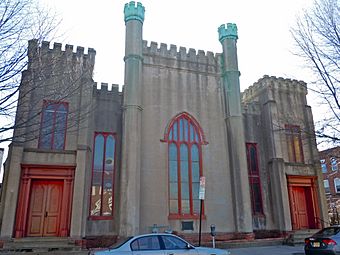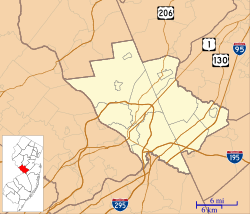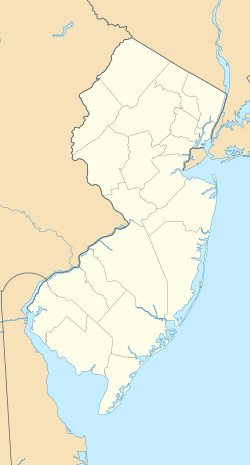St. Michael's Church (Trenton, New Jersey) facts for kids
St. Michael's Church is a very old and important church in Trenton, New Jersey. It was started way back in 1703. This church is one of the first parishes of the Episcopal Diocese of New Jersey.
The building you see today at 140 North Warren Street was built between 1747 and 1748. It was updated a few times, in 1810 and again in 1847–1848. Because of its long history, St. Michael's Episcopal Church was added to the National Register of Historic Places on April 29, 1982.
The people who go to St. Michael's Church have been a big part of Trenton's history and culture. They have been involved in the city since the church began in 1703.
Contents
A Look Back: The History of St. Michael's Church
Starting in the 1700s
St. Michael's Church began as a parish in 1703 in an area called Hopewell Township. The first church building was for the Church of England, which is a Christian church. It was built in 1704 on a place known as "Breese Farm."
In 1708, Queen Anne of Great Britain gave special gifts to the church. These gifts are now kept safe at the New Jersey State Museum.
The main part of St. Michael's Church, where people gather for services, was built in 1747–1748. This is the building that stands today on North Warren Street in Trenton. The church was changed quite a bit in 1810. The unique towers you see facing Warren Street are from that 1810 update.
The American Revolution and the Church
During the American Revolutionary War in 1776, the church building was closed. This happened because the people in the church were split. Some supported the Revolutionaries (who wanted independence from Britain), and others were Loyalists (who wanted to stay loyal to Britain).
While the church was closed, it was used as a hospital. The churchyard, which is the land around the church, became a burial ground. Many Hessian soldiers were buried there. These were German soldiers who fought for the British during the war.
After the war, Reverend William Frazer, who had been a Loyalist, was allowed to return as the church's leader. Reverend Frazer also ran a school. In the early 1790s, two of Alexander Hamilton's oldest sons, Philip and Alexander Jr., went to his school.
The 1800s and Important Meetings
In 1801, St. Michael's Church hosted a very important meeting. It was the seventh General Convention of the Episcopal Church. At this meeting, leaders of the church agreed to a new version of the Anglican Church's rules. This meant the Protestant Episcopal Church in the USA could be part of the Anglican Communion without having to promise loyalty to the British crown.
The 1900s to Today
In the early 1900s, some members of St. Michael's Church helped start Trinity Episcopal Cathedral. This cathedral is now the main church for the Bishop of the Episcopal Diocese of New Jersey.
A special moment in the church's recent history happened in 1955. St. Michael's Church decided to welcome and join with an African American church called St. Monica's Parish. This was a big step towards racial integration, meaning people of different races coming together. The church has remained a diverse community, welcoming people from different backgrounds and languages.
In 1973, St. Michael's became a "mission" of the Episcopal Diocese of New Jersey. This means it gets support from the larger church organization. In 2006, the church received a grant of $50,000 to study its building and grounds because of their historical importance. In 2015, a Lutheran pastor, Reverend Mark David Johnson, became the vicar (leader) of St. Michael's Church.
During 2005 and 2006, there were special events called Patriot's Week. These events re-enacted parts of the Battle of Trenton. Re-enactors, who dress up as soldiers from the Continental Army, marched past the church.
Church Buildings and Burial Grounds
St. Michael's Church has had different places of worship and burial grounds over its long history.
- The Hopewell Church Building: The very first Church of England building was built in 1704. It was on "Breese Farm," which is now part of Ewing Township, NJ.
- The North Warren Church Building (1748-Present): The main church building on North Warren Street was updated to look a bit like Lambeth Palace in England. It has two turrets (small towers). The original bell tower is no longer there, but the turrets remain. Inside the main church, you can see two beautiful Tiffany stained-glass windows.
Important People Buried in the Churchyards
The churchyards of St. Michael's are where many important people from American history are buried.
- The Hopewell Churchyard: William Trent was the person who founded the city of Trenton. His wife, Mary Trent, was buried in the Hopewell Graveyard.
- The North Warren (Trenton) Churchyard: In the churchyard on North Warren Street, there is a large stone slab. It has special symbols from the Masonic group. This marks the grave of David Brearley. He was a delegate from New Jersey who helped write the U.S. Constitution in 1787. He was also the first Chief Justice of the New Jersey Supreme Court. Also buried here is the niece of Napoleon Bonaparte, a famous French leader. She was the daughter of Joseph Bonaparte, who lived nearby in Bordentown, New Jersey.





